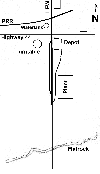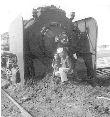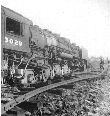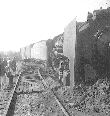Wrecks and Derailments - Part 1
Unless otherwise marked, the photos on this page were either taken by Maurice Lewman or are from his collection. Drawings digitized by Roger P. Hensley.
(Click on the small graphic to see the larger one.)
April 12, 2003
Many people may not be aware that the train and engine crews keep a time book containing the trips worked. This contains date, train number, engine numbers, on and off duty and the conductor or fireman. These time books are a history of a railroaders work life on the railroad.
While looking through the January 1959 time book, I saw that the month was the normal trips from South Anderson to Elkhart and Jeffersonville Indiana except for two days, the 13th and the 16th. I will start out with the 16th just because it was different. Because we did not have passenger trains this adds a little spice to the life of an extra engineer.
The crew dispatcher calls and wants me to deadhead, South Anderson to Greensburg, to pilot the Riley to South Anderson. Now, on the Big 4 that could only mean one train, the pride of the Indiana Division, the James Whitcomb Riley, named after the Hoosier Poet. In later years at Avon yards the Chicago Division engineers all claimed to have fired the Riley and they were about all the same age. When we figured it out, there were 5 fireman on the Riley each trip. It did run 80 and 90 mph and I know from a good source, that west of Lafayette after the diesels came, 114 mph was not unusual.
Back to the story. The Riley was late at Greensburg so the delay was not great because of our late arrival. I show that time on duty for myself and conductor pilot, Tom McFarland, was 9:15am. As I climbed on the engine, the fireman on the Riley was John Eversole, who I worked with several times on the Greensburg yard engine. John working as an extra engineer and myself as fireman. I asked the engineer if he wanted to run the engine. "No, you run," John says. "You ran the yard engine faster than we will be going to South Anderson." The conductor comes out with the orders, tells us we will back up and use the east leg of the wye to leave town and the yard crew will take care of the switches. It is 57 miles to South Anderson and running time is an hour and 35 minutes. The only stops will be two at Rushville. When we stop there for the PRR there is no indication of a wreck, three days prior, which we will cover in the story. The rest of the trip was uneventful and my time book shows off duty at 12:20pm. Pilots from the Beeline will take the train to Indianapolis.
The month of January 1959 was a month of varieties. Looking at the different trips, I was engineer on six jobs and on my assigned job as a pool fireman, I worked with several extra engineers. On the 9th & 11th of January, I worked on the 1811, 1810, the units involved in the following story.
On any division derailments were almost a way of life in the days past because of the number of locals and yard engines working at any one time. Wrecks or collisions that cost lives are always bad and as a rule involve much loss of equipment. The January 13 time book record shows that I deadheaded to Rushville, Indiana and was on duty at 11:30am. The wreck had been cleaned up and the track repaired and everything was ready to go. The fireman, Jim Sturgon, was called earlier and someone did not think to call an engineer. The mechanics of the wreck were simple. East bound crossing in front of north bound, north bound did not stop short of east bound.

  Now, the rest of the story. Rushville, like most towns on the Michigan Division, sits next to a river or creek making it uphill both ways out of town. Rushville was not a hard place to stop but this was the first time the fireman had stopped a train at this location. As he approached the stop, it looked as if he needed more brake pressure not realizing that the approach to the stop was slightly uphill, although you started into town going downhill.
Now, the rest of the story. Rushville, like most towns on the Michigan Division, sits next to a river or creek making it uphill both ways out of town. Rushville was not a hard place to stop but this was the first time the fireman had stopped a train at this location. As he approached the stop, it looked as if he needed more brake pressure not realizing that the approach to the stop was slightly uphill, although you started into town going downhill.

When he sensed the train was going to stop before the intended point, he released the brake on the entire train allowing the rear end, which was coming downhill, to start shoving the train and by the time the brakes could again take effect, it was too late, although the brakes were applied in emergency. The pictures show the results. A small hole 6 x 6 inches and a broken speed recorder cable, all on the left side of the engine, was the extent of damage to the unit 1811. The rear unit, 1810, was not damaged and no one was injured.
Rushville Wreck 1/13/1959
Photographs by Phyllis Pangburn, NYC Dispatcher.
|
 Rushville IN Jan, 13, 1959 #78 failed to stop for PRR
Rushville IN Jan, 13, 1959 #78 failed to stop for PRR
Train leaving crossing after being rerailed.
Engingeer M.E. Lewman, Fireman J. Sturgon
Maurice Lewman Collection.
|
We will start at North Vernon and work our way north. These wrecks and derailments are of the ones I have heard about or know about personally. Many others happened and are lost to time. Brewersville sits in the valley of Sand Creek and as usual it is uphill in both directions to leave town. In 1960 when they started hauling automobiles by rail, the height restrictions would not let these cars be shipped south of Cincinnati so we enjoyed at least two years of automobile trains from South Anderson to Jeffersonville and this was the train involved in this derailment.
Coming south at Brewersville, you have a curve to the right and cross Sand Creek at 90 degree angle. South of the bridge about 100 yards and starting upgrade a curve to the left and 100 yards farther a curve to the right and south to the top of the grade. I never knew the cause, but after crossing the bridge and as the middle of the train started around the second curve, a car jumped the track and of course about 10 cars continued straight into the bank of the cut. Headed straight into the bank was a carload of autos and only one or two were damaged but some dealer bought a carload of new automobiles for a few hundred dollars.
The next derailment was at Craig, one and one half miles west of Greensburg. This was in the late 1920's. A northbound derailed at Craig which included a tank car of alcohol. The story goes that as soon as the people of Greensburg were aware of the tank car and its contents, there was not an empty washtub or bucket in Greensburg that was not at the wreck site because the tank car was leaking.
At Sandusky about 1949, not a head-on but close. The signal at Sandusky southbound was located such that you had a glimpse of it to tell if it was green or red. The southbound had a meet with a northbound freight at Sandusky. The northbound held the main and the head brakeman per the rules, lined the switch for the siding. The southbound light engine forgot the meet and overlooked the signal indication and could not stop, heading in the switch at a high speed. They did not derail but slid the track over 5 feet.

  The next head-on happened in April 1950 at Milroy. The northbond local was to meet #71 at Milroy. Usually this meet was at Greensburg or Rushville. Whatever the reason, the local arrived at Milroy and stayed south of the depot. The siding switch was north of the depot and under the manual block rules then in effect, the local could not pass the signal to enter the siding until the southbound arrived. With the signal red for the southbound, the local's crew and operator waited for #71, not realizing the smoke from the trash the elevator was burning was blocking #71's view of the signal and the local sitting south of the depot around a curve in the track. As the smoke cleared and the red signal came into view it was too late to stop. Hitting the local, they drove the local south 185 feet, jackknifing the local's engine and a few cars. The only injury was to the conductor on the local.
The next head-on happened in April 1950 at Milroy. The northbond local was to meet #71 at Milroy. Usually this meet was at Greensburg or Rushville. Whatever the reason, the local arrived at Milroy and stayed south of the depot. The siding switch was north of the depot and under the manual block rules then in effect, the local could not pass the signal to enter the siding until the southbound arrived. With the signal red for the southbound, the local's crew and operator waited for #71, not realizing the smoke from the trash the elevator was burning was blocking #71's view of the signal and the local sitting south of the depot around a curve in the track. As the smoke cleared and the red signal came into view it was too late to stop. Hitting the local, they drove the local south 185 feet, jackknifing the local's engine and a few cars. The only injury was to the conductor on the local.
The next accident was at Rushville and was covered earlier. In 1906, one mile north of Carthage on a curve, there was a head-on collision taking three lives and destroying much equipment. At this time, trains operated by timetable schedule and train orders. The northbound had departed Carthage eight minutes ahead of scheduled time. This time would have given the southbound time to have arrived at Carthage. Why no one on the head end of the northbound caught this eight minute error was not stated.
 In Knightstown in 1944, at the railroad crossing at US 40, a truck ran into the side of the train derailing several cars and no injuries. One mile north of Knightstown in 1911, eleven cars derailed with no injuries. In Shirley, in 1891, a northbound ran through an eastbound at the crossing of the two railroads. And in later years on the east wye at Shirley, engine and cars would derail due to the sharpness of the curve. The track gauge would spread and if not checked often and with the larger engines, they would fall between the rails.
In Knightstown in 1944, at the railroad crossing at US 40, a truck ran into the side of the train derailing several cars and no injuries. One mile north of Knightstown in 1911, eleven cars derailed with no injuries. In Shirley, in 1891, a northbound ran through an eastbound at the crossing of the two railroads. And in later years on the east wye at Shirley, engine and cars would derail due to the sharpness of the curve. The track gauge would spread and if not checked often and with the larger engines, they would fall between the rails.
Here is a short story to show how easy a derailment could occur. While I was still working on the track gang at Markleville, we were inspecting track on the south end and at a crossing you could see where an empty car had jumped the track on the morning freight. Following the light wheel cuts on the ties for about one half mile, it came to a private crossing where a farmer crossed from field to field. There was nothing special about this crossing, just a hump of dirt between the rails but it was enough to re-rail the car and it continued on to its destination.


 On May 10, 1954, #78, the freight from Louisville, Ky., was arriving at South Anderson. Someone had unlatched the south wye switch, which you would not see from the engine cab of the 3029. The 3029 hit the gapped switch points and jumped the track plowing into the ground almost to the headlight. It was the end to one of the best L-3 locomotive that I ever worked on. On May 10, 1954, #78, the freight from Louisville, Ky., was arriving at South Anderson. Someone had unlatched the south wye switch, which you would not see from the engine cab of the 3029. The 3029 hit the gapped switch points and jumped the track plowing into the ground almost to the headlight. It was the end to one of the best L-3 locomotive that I ever worked on.
In part 2, we'll cover South Anderson to Goshen, Indiana.
Maurice Lewman
Maurice worked the Michigan Division from 1947-1981. He then worked on the Bee Line from 1981-1992. From 1947 until august 1950, he worked on the section at Shirley and Markleville. In 1950 he started firing on steam and then on through the diesels. Maurice said, "I had the pleasure of working with C. C. Staley and Ron Buser many times."
|






















